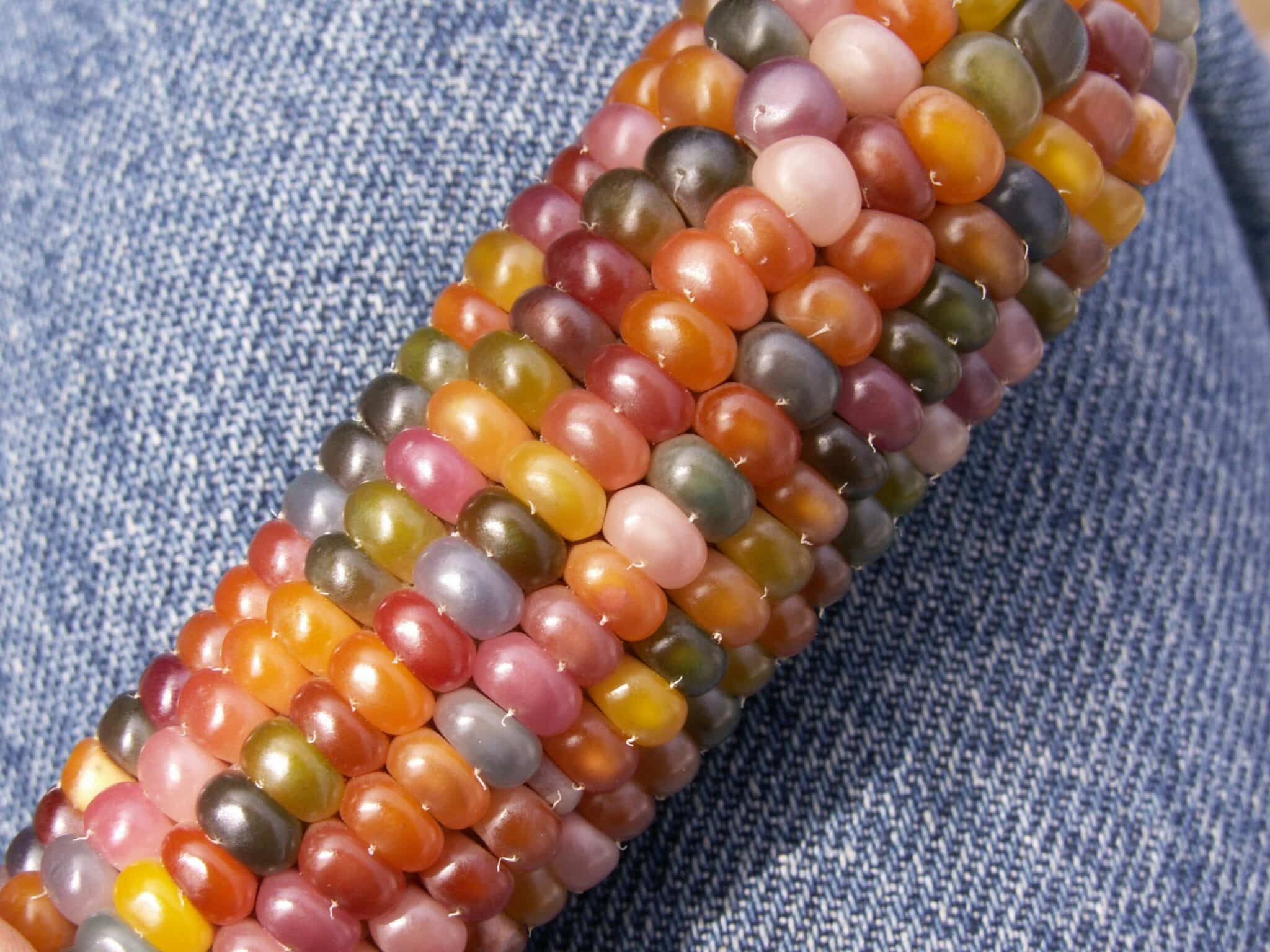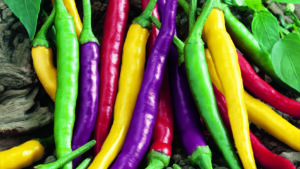The story of how this extremely striking crop was developed is truly fascinating, and one that’s far from over.
Like anyone and anything of true value, the beauty of Glass Gem goes below the surface. In addition to providing an inspiring and unique experience for all who grow it, this stunning corn is also a living reminder of how many Native American tribes have re-connected with their traditional cultures, and a living symbol of inspiration for their future.
Glass Gem corn (also known as “Rainbow Jewel,” the reason for this will be explained later) produces a diversity of striking, translucent, jewel-colored ears, each and every one of them unique. It’s a combination flint and popcorn types of corn. The smaller-kernelled ones will pop, while the larger flat-kernelled ones are best ground into flour. But of course, many ears are simply kept as a feast for the eyes.
This corn is now well-known across many parts of the U.S. and beyond, due in large part to the keen eye of Carl Barnes, a part-Cherokee farmer and corn breeder who died in 2016. Barnes developed the rainbow-colored corn through allowing Pawnee miniature popcorn corn, Osage red flint corns and likely Cherokee Long-ear corn to interbreed, explains Greg Schoen. Schoen first met Barnes in 1994 at a herbalists’ gathering and was struck by some small ears of corn Barnes had on display, ears with kernels of all colors. That year and in the years to follow, Schoen became one of several people to whom Carl mentored, gave seed and encouraged further sharing.
“Over the next few years, Carl shared additional samples of the rainbow corn seed with me so that I had a broader genetic base,” Schoen explains. “Carl also gave me seed of a number of his larger traditional native flour corns. During this time, my friendship with Carl grew and I visited him at his home many times. His collection room was full of shelves and cabinets of seeds in jars and displays of seed and ears of corn originating from many Native American peoples.” (Barnes has also been central to the protection of White Eagle Corn, part of a recent seed submission to the Svalbard Seed Vault.)
From 2005 to 2008 in New Mexico, Schoen grew the rainbow corn along with traditional Pueblo miniature and blue corns, on the land of Jose Lucero. Schoen had a feeling it would be beneficial for the pollen of the smaller rainbow corns to mingle with that of the robust Southwestern strains, diversifying genetics that might have narrowed over the years with his and Carl’s somewhat limited plantings up to that point. His instincts were right. Amazing colors and patterns emerged.
“Every year, I began to see the corn move towards its potential,” Schoen says. “In 2008, we selected our best seed and planted only rainbow corn.”
Having shared this seed to others over the years, it was in 2009 that Schoen realized he should give samples of the seed to Bill McDorman, an Arizonian he respected, who was conducting classes training young people about growing and preserving seeds. Bill and his partner Belle later became directors of Native Seeds/SEARCH, also in Arizona, a non-profit organization dedicated to the preservation of traditional and indigenous crops of the American Southwest and northern Mexico. The couple later founded an educational nonprofit organization called the Rocky Mountain Seed Alliance (RMSA).
In 2013, a large batch of the corn was grown at Native Seeds/SEARCH and in 2014, widespread distribution began. At first only Native Seeds/SEARCH sold seed, and the income supported the organization’s conservation activities. Soon, some other seed companies also started selling the seed as well, and that’s where its trajectory deviated somewhat from what Barnes, Schoen and others had intended.
“While seed companies do provide a way for people to access the seed of this corn and other heritage seeds, and commerce is part of our lives today, some people made a lot of money on it and used it more for self-promotion,” Schoen explains. “On occasion in craft markets, I saw seed of this corn being sold that seemed compromised, with more yellows and dull colors. Yet I admit that many of the small catalogue seed sources did present it in a respectful way.
“I just want people to understand that this corn was originally intended to be freely shared. The ancestral seed of this and all corn has been traded and shared among Indigenous peoples for thousands of years and that’s the way I favor. It becomes an unbroken lineage not tainted by the conditionality of the marketplace. That’s the sacredness of it.”
At this point, the corn is being grown in several countries and still being picked up by new seed firms. West Coast Seeds in Delta, British Columbia, for example, is offering Glass Gem in 2021 for the first time.
However, Schoen remains in favor of the seed being grown and shared by the “seed stewards of the world,” growing it as a labor of love and sharing it with others as part of local culture. In 2012, he and others established a seed collection for this corn and other seeds with Grandmother Flordemayo in Estancia, New Mexico, to preserve heritage seeds and support and educate seed stewards. Recently, to help promote the free sharing of the Glass Gem seed, Schoen and others have chosen to rename it.
“When the seed was developing into its full expression, ‘Glass Gem’ was one of the many names I used for the different color patterns I was seeing, and when I took some samples to Bill, that’s a name he noticed on one of the photographs I also gave him,” Schoen says. “He started using that name and that worked for me. But soon it became clear that ‘Glass Gem’ was its commercial name. For that reason, I along with those at RMSA are now referring to this corn that is shared, rather than sold, as ‘Rainbow Jewel’.”
Those interested in growing this corn can participate in RMSA’s Seed Steward program, in which individuals commit to preserving and sharing seed diversity. There are currently over 300 Seed Stewards, says McDorman. The seed can also be purchased at Native Seeds/SEARCH. Collections Curator Sheryl Joy explains that “definitely a large part of our income comes from seed sales and Glass Gem is by far the most popular. If consumers order this corn from us, this supports us to expand the amount of seed we give away through our Native American Seed Request Program and Community Seed Grants.”
She adds that “with COVID-19 and the hardships that many people are facing this year, these programs have been extremely busy and we expect that to continue. We grow most of the seed for our nearly 2000 accessions but we are also expanding our network of farmer-partners.”
It’s clear that the story of this beautiful corn is far from over, and for his part, Schoen says he’s “very glad” to have been a part of its journey. He is also very pleased “that it has inspired so many people to appreciate the beauty of nature and to get into seed saving.”











